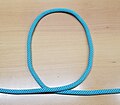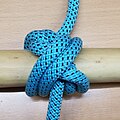This article includes a list of general references, but it lacks sufficient corresponding inline citations .(March 2013) |
| Boa knot | |
|---|---|
 | |
| Category | Binding |
| Origin | Peter Collingwood in 1996 |
| Related | strangle knot, double constrictor knot |
| Typical use | Best used for securing objects in cylindrical loads |
The boa knot [1] [2] [3] [4] is a modern binding knot invented by weaver Peter Collingwood in 1996. His intention was to develop a knot that would hold well when the constricted object was cut close to the winds of the knot.
Contents
The boa knot is related to the strangle knot and the double constrictor knot. It combines both the structure and qualities of these other two knots. The boa knot can be very difficult to untie and is inappropriate when frequent or fast untying is needed. The knotted part needs to lie over a convex surface to hold.
The boa knot is best used for securing objects in cylindrical loads. Said knot is hard to move around.









